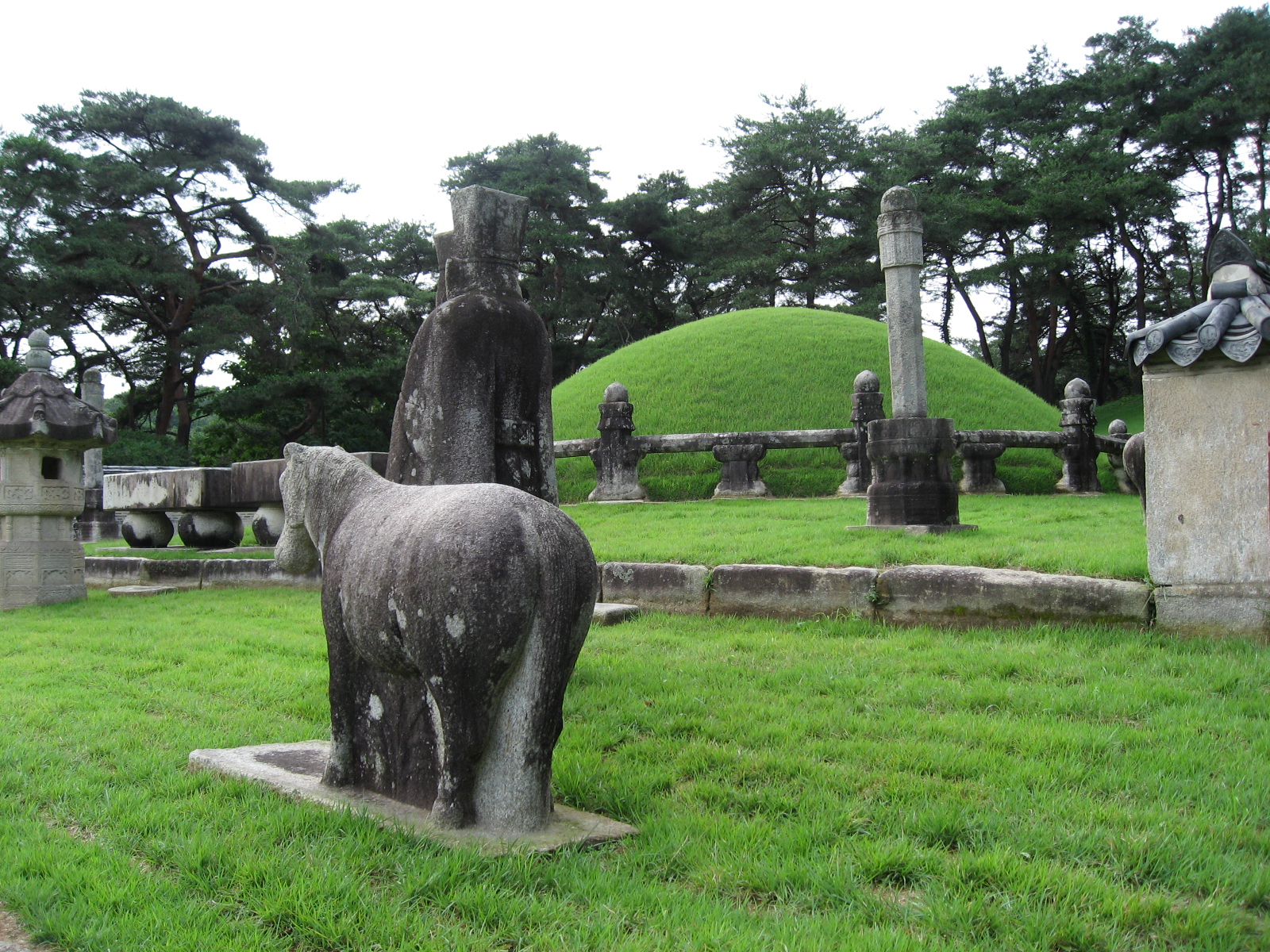- Royal Tombs of the Joseon Dynasty
Infobox Korean name

caption = The tomb of King Sejong the Great exemplifies the general style of Joseon Dynasty royal tombs.
hangul = 조선왕릉
hanja = linktext|朝鮮|王|陵
rr = Joseon wangneung
mr = Chosŏn wangnŭngThe Royal Tombs of the Joseon Dynasty are a group oftomb s of members of theKorea nJoseon Dynasty (1392-1910). The tombs have been registered by theSouth Korea n government as a tentativeUNESCO World Heritage site since January, 16, 2006.The tombs
The tombs are classified into two types. Tombs of the kings and queens and those posthumously granted the title of king or queen, were interred in Neung-type tombs.
Crown Prince s and their wives, as well as the parents of royalty, were interred in Won-type tombs. Almost all of the royal tombs are located 40 kilometers fromHanseong (present-daySeoul ). However, the Jangneung tomb is inYeongwol County,Gangwon-do , while the Yeongneung tombs are inYeoju County,Gyeonggi-do . Tombs were made for individuals as well as family groups. There are 40 Neung-type tombs and 13 Won-type tombs, thus creating a total of 53 royal tombs.Joseon-era royal tombs followed the guidelines outlined in Chinese
Confucian texts, such as the "Book of Rites " ("Li Ji") and the "Rites of Zhou " ("Zhou Li"). Many factors went into consideration when deciding the location of a tomb, such as the distance fromHanyang , the distance in relation to other royal tombs, the accessibility of the location, and Korean traditions of "pungsu" (geomancy ). The tomb construction also took into account traditional burial rituals of Korea and the natural environment.Donggureung Tomb Cluster
This cluster of tombs represents the best sample of royal family group tombs from the Joseon Dynasty. Seven kings and ten queens are interred in nine Neung-type tombs. Famous tombs in this group include the Geonwolleung tomb for King Taejo, the founder of the Joseon Dynasty. The Gyeongneung tomb holds the remains of King Hyeonjong, who ruled from 1834 to 1849, and his wives Queen Hyohyeon and Queen Hyojeong. This group of tombs represents the evolution of Joseon-style tomb architecture over a period of five hundred years.
eosamneung Tomb Cluster
The Seosamneung (lit. "Three Western Neung") tomb cluster is located in
Goyang City,Gyeonggi Province, which is convert|20|km|mi from Seoul. The name of the tomb comes from the fact that the three royal tombs (Neung) are located in the western suburb of the Capital. Queen Janggyeong was interred in Huineung tomb. Hyoreung tomb holds the remains of King Injong and his wife Queen Insong. King Cheoljong and Queen Cheolin are interred in Yereung. Fifty other tombs holding the remains of princes, princesses, and royal concubines are also located in this tomb cluster. Notably, monuments in various styles built to house the royalplacenta andumbilical cord s, known as "taesil", which had once been scattered all over Korea, have been gathered and now rest in this tomb cluster.Gwangneung
Gwangneung is located in
Namyangju City, Gyeonggi Province. The tomb contains the remains of King Sejo and his wife Queen Jeonghui. The two tombs were built in 1468 and 1483 respectively. Gwangneung is important because changes taking place in the construction of royal tombs are evident in its construction. Screening rocks were not installed at this tomb. Instead of an outer coffin stone,quicklime was used instead. Another break from tradition was the fact that the reverential access was not built. Finally, only tone T-shaped ritual shrine was built for both burial mounds. This change in tomb architecture came from the last wishes of the king and reflects a new frugal style that influenced later royal tomb construction.Hongneung and Yureung
The styles of these two tombs reflect the political changes Korea was experiencing during the waning days of the Joseon Dynasty. With the declaration of the
Korean Empire , the style of the tombs of the last two rulers of the Joseon Dynasty, Emperor Gojong and Emperor Sunjong were designed to reflect their new status. Hongneung holds the remains of Emperor Gojong andEmpress Myeongseong . Yureung tomb holds the remains of Emperor Sunjong,Empress Sunmyeonghyo and Empress Sunjeonghyo. Other notable tombs include Yeongwon, the tomb of Crown Prince Yeongwang and Crown PrincessYi Bangja .Gallery
See also
*
List of Korea-related topics
*Joseon Dynasty External links
* [http://whc.unesco.org/en/tentativelists/2097/ Royal Tombs of the Joseon Dynasty] UNESCO
* [http://www.cha.go.kr/english/heritage_book/world_heritage.pdf World Heritage in Korea] (pdf)
* [http://www.orientalarchitecture.com/ Oriental Architecture]
Wikimedia Foundation. 2010.
